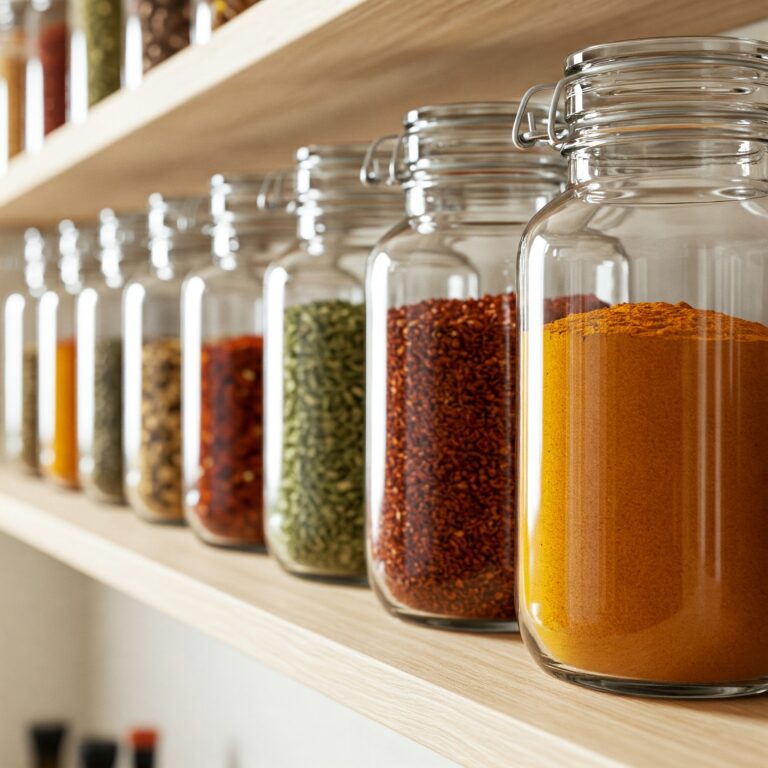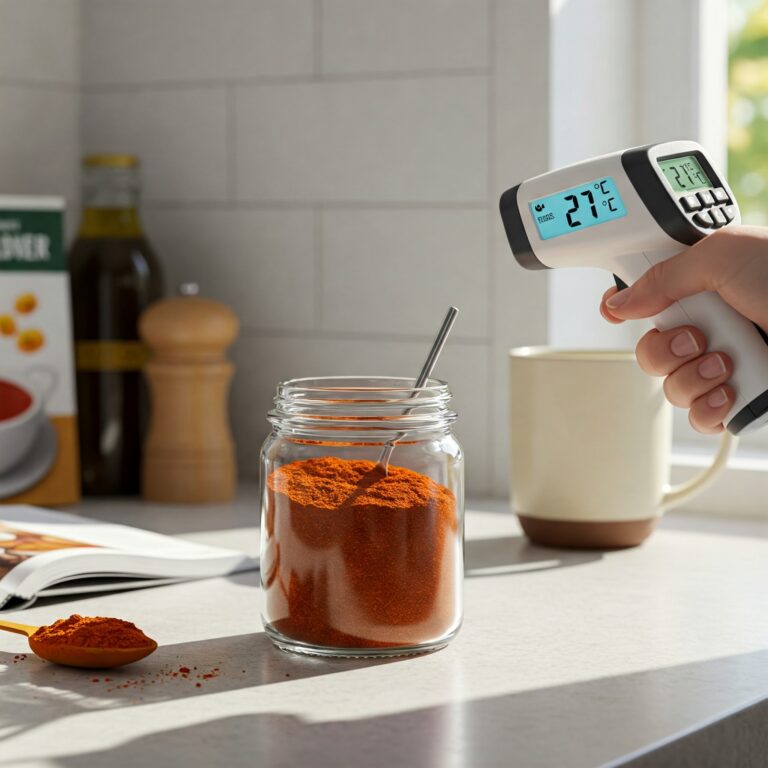Have you ever opened your spice cabinet only to be greeted by a chaotic jumble of jars and packets? 🌶️🧂 Or worse, reached for your favorite Indian spice blend, only to find it’s lost its vibrant aroma? If you’re nodding in agreement, you’re not alone. Many home cooks struggle with properly storing their precious Indian spices, unknowingly compromising their flavors and potency.
But fear not! The art of storing Indian spices isn’t as complex as crafting the perfect curry. With a few simple tricks up your sleeve, you can transform your spice storage from a haphazard mess into an organized, flavor-preserving haven. Imagine opening your cabinet to find neatly arranged, aromatic spices ready to elevate your next culinary creation. 🍛✨
In this blog post, we’ll spice up your storage game with six essential tips. From choosing the right containers to monitoring freshness, we’ll guide you through creating the ideal conditions for your beloved Indian spices. Get ready to embark on a journey that will not only extend the life of your spices but also enhance your cooking experience!

Choose the Right Storage Containers
A. Airtight containers for maximum freshness
Airtight containers are essential for preserving the potency and flavor of Indian spices. These containers create a barrier against air, moisture, and light, which can degrade spices over time. Look for containers with tight-fitting lids, preferably with rubber gaskets for an extra seal. Some popular options include:
- Mason jars with screw-top lids
- Stainless steel canisters with locking mechanisms
- Ceramic jars with silicone seals
B. Glass vs. plastic: pros and cons
| Material | Pros | Cons |
|---|---|---|
| Glass | Non-reactive – Easy to clean- Doesn’t retain odors | Breakable- Heavier- More expensive |
| Plastic | Lightweight- Durable- Affordable | Can absorb odors- May react with spices- Less eco-friendly |
Choose glass for long-term storage and plastic for convenience and portability.
C. Size considerations for different spices
Select container sizes based on:
- Frequency of use
- Quantity purchased
- Spice volume changes (e.g., whole vs. ground)
Use smaller containers for rarely used spices and larger ones for staples like turmeric or cumin.
D. Labeling for easy identification
Proper labeling is crucial for an organized spice collection:
- Use waterproof labels
- Include spice name and purchase date
- Consider color-coding for different categories (e.g., whole spices, ground spices, blends)
With the right containers and organization, your Indian spices will stay fresh and easily accessible for all your culinary adventures. Next, we’ll explore how to create ideal storage conditions to further extend the life of your spices.

Create Ideal Storage Conditions
A. Temperature control for longevity
Maintaining the right temperature is crucial for preserving the potency and flavor of Indian spices. Ideally, store your spices in a cool, dark place with temperatures between 50°F to 70°F (10°C to 21°C). Avoid placing spices near heat sources like stoves or ovens, as excessive heat can cause them to lose their aromatic compounds and essential oils.
B. Protection from direct sunlight
Sunlight is a natural enemy of spice freshness. UV rays can break down the volatile oils in spices, causing them to lose their flavor and aroma. To protect your spices:
- Store them in opaque containers
- Keep spice racks away from windows
- Use cabinet space or drawers for storage
C. Humidity management techniques
Moisture is another factor that can significantly impact spice quality. High humidity can lead to clumping, mold growth, and loss of flavor. Here are some techniques to manage humidity:
- Use airtight containers
- Add silica gel packets to spice jars
- Store spices away from the sink or stove
| Humidity Level | Effect on Spices | Prevention Method |
|---|---|---|
| Low (< 30%) | Drying out | Airtight storage |
| Moderate (30-60%) | Ideal | Regular containers |
| High (> 60%) | Clumping, mold | Silica gel packets |
D. Avoiding strong odors in storage areas
Indian spices are known for their strong aromas, but they can also absorb odors from their surroundings. To preserve their authentic flavors:
- Keep spices away from strong-smelling foods
- Avoid storing near cleaning products or air fresheners
- Use separate containers for pungent spices like asafoetida
By creating these ideal storage conditions, you’ll ensure your Indian spices remain fresh and flavorful for longer periods. Next, we’ll explore how to effectively organize your spice collection for easy access and use.
Organize Your Spice Collection
A. Alphabetical arrangement for quick access
Organizing your Indian spices alphabetically is a classic and efficient method. This system allows for quick and easy access, especially when you’re in the middle of cooking. Create a list or label your containers clearly to streamline your culinary process.
B. Grouping by cuisine or dish type
For those who frequently cook specific Indian dishes, grouping spices by cuisine or dish type can be incredibly helpful. Here’s an example of how you might organize your spices:
| Cuisine/Dish Type | Essential Spices |
|---|---|
| Garam Masala | Cardamom, Cinnamon, Cloves, Cumin |
| Tandoori | Coriander, Cumin, Paprika, Turmeric |
| Curry | Cumin, Coriander, Turmeric, Chili powder |
C. Frequency of use organization
Arrange your spices based on how often you use them. Keep frequently used spices like turmeric, cumin, and coriander at eye level or in easily accessible spots. Less frequently used spices can be stored in harder-to-reach areas.
D. Vertical storage solutions to save space
Maximize your storage space by utilizing vertical solutions:
- Wall-mounted magnetic strips
- Door-mounted racks
- Tiered shelving units
- Lazy Susan turntables
These options not only save space but also make your spices more visible and accessible.
E. Rotating stock to ensure freshness
Implement a first-in, first-out system to maintain the freshness of your spices. When purchasing new spices, place them behind older ones. This ensures you use the older spices first, preventing waste and maintaining optimal flavor in your dishes.
Now that we’ve covered how to organize your spice collection effectively, let’s move on to the crucial aspects of preserving whole versus ground spices.

Preserve Whole vs. Ground Spices
A. Benefits of storing whole spices
Storing whole spices offers several advantages over pre-ground varieties:
- Longer shelf life
- Enhanced flavor retention
- Versatility in cooking
- Better aroma preservation
| Aspect | Whole Spices | Ground Spices |
|---|---|---|
| Shelf Life | 1-3 years | 6-12 months |
| Flavor Intensity | Strong | Diminishes over time |
| Versatility | Can be used whole or ground | Limited to ground form |
| Aroma | Potent | Fades quickly |
B. Proper grinding techniques
To maximize flavor when using whole spices:
- Toast spices before grinding
- Use a mortar and pestle for small batches
- Employ an electric grinder for larger quantities
- Grind only what you need for immediate use
C. Shelf life differences between whole and ground
Whole spices generally last longer than their ground counterparts due to less surface area exposure to air and moisture. While whole spices can maintain their potency for 1-3 years, ground spices typically lose their flavor within 6-12 months.
D. Small batch grinding for optimal flavor
Grinding spices in small batches ensures:
- Maximum freshness
- Tailored blends for specific dishes
- Reduced waste
- Ability to experiment with flavor combinations
Now that we’ve explored the benefits of whole spices and proper grinding techniques, let’s move on to the importance of handling spices correctly to maintain their quality.

Handle Spices Correctly
A. Clean, dry utensils for scooping
When handling your precious Indian spices, it’s crucial to use clean and dry utensils for scooping. This practice not only maintains the quality of your spices but also extends their shelf life. Here’s a list of recommended utensils for handling spices:
- Stainless steel measuring spoons
- Wooden or bamboo spoons
- Ceramic spoons
- Clean, dry fingers (for small amounts)
Avoid using wet or damp utensils, as moisture can lead to clumping and spoilage of your spices.
B. Avoiding cross-contamination
Cross-contamination can alter the flavors of your spices and compromise their quality. To prevent this, follow these guidelines:
- Use separate spoons for each spice
- Clean utensils between uses
- Avoid touching spices directly with hands
- Store similar spices together to minimize mix-ups
| Spice Group | Examples |
|---|---|
| Aromatic Seeds | Cumin, Coriander, Fennel |
| Powdered Spices | Turmeric, Red Chili, Garam Masala |
| Whole Spices | Cinnamon Sticks, Cardamom Pods, Cloves |
C. Proper sealing after each use
Ensuring your spice containers are properly sealed after each use is vital for maintaining freshness and potency. Here are some tips:
- Use airtight containers with secure lids
- Check for any spice residue on the rim before closing
- Store containers upright to prevent spills
- Consider using vacuum-sealed containers for long-term storage
By following these practices, you’ll preserve the vibrant flavors and aromas of your Indian spices, ensuring they’re always ready to elevate your culinary creations. Next, we’ll explore how to monitor spice freshness to ensure you’re always cooking with the best ingredients.

Monitor Spice Freshness
A. Signs of spoilage to watch for
When monitoring your Indian spices for freshness, keep an eye out for these telltale signs of spoilage:
- Loss of aroma
- Faded color
- Clumping or caking
- Presence of mold or insects
B. Average shelf life of common Indian spices
| Spice | Whole | Ground |
|---|---|---|
| Turmeric | 3-4 years | 2-3 years |
| Cumin | 3-4 years | 6-12 months |
| Coriander | 3-4 years | 2-3 years |
| Cardamom | 2-3 years | 6-8 months |
| Cinnamon | 3-4 years | 2-3 years |
C. Best practices for spice rotation
To maintain the freshness of your Indian spices:
- Use the “first in, first out” method
- Label spices with purchase dates
- Store frequently used spices in smaller quantities
- Replenish spices in smaller batches
D. When to discard old spices
While spices don’t necessarily spoil, they do lose potency over time. Discard spices when:
- They no longer have a distinct aroma
- The color has significantly faded
- You notice any signs of mold or insect infestation
- They’ve been stored for longer than their recommended shelf life
Remember, proper storage in airtight containers away from heat, light, and moisture can significantly extend the life of your Indian spices. Regular checks and proper rotation will ensure you always have fresh, flavorful spices for your culinary creations. Next, we’ll explore some advanced tips for maintaining the quality of your spice collection.
Proper storage of Indian spices is crucial for maintaining their flavor, aroma, and potency. By choosing the right containers, creating ideal storage conditions, and organizing your spice collection effectively, you can ensure your spices remain fresh and flavorful for longer periods. Remember to handle your spices correctly, preserve whole spices when possible, and regularly monitor their freshness to maintain the quality of your culinary creations.
Implementing these storage practices will not only extend the life of your Indian spices but also enhance your cooking experience. Take the time to properly store and care for your spices, and you’ll be rewarded with rich, vibrant flavors in every dish you prepare. Start organizing your spice collection today and elevate your Indian cuisine to new heights of authenticity and taste.
“Need premium Indian spices in bulk? Get pure, authentic quality with global shipping from Shri Anikrat Export Ventures—perfect for your business.”
Share about your favorite spices or any personal tips in the comments—we’d love to hear from you! 

Good
Good